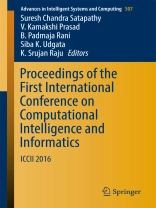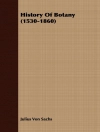The book covers a variety of topics which include data mining and data warehousing, high performance computing, parallel and distributed computing, computational intelligence, soft computing, big data, cloud computing, grid computing, cognitive computing, image processing, computer networks, wireless networks, social networks, wireless sensor networks, information and network security, web security, internet of things, bioinformatics and geoinformatics. The book is a collection of best papers submitted in the First International Conference on Computational Intelligence and Informatics (ICCII 2016) held during 28-30 May 2016 at JNTUH CEH, Hyderabad, India. It was hosted by Department of Computer Science and Engineering, JNTUH College of Engineering in association with Division V (Education & Research) CSI, India.
Inhoudsopgave
Chapter 1. GUI Based Automated Data Analysis System Using Matlab®.- Chapter 2. A Survey Study on Singular Value Decomposition and Genetic Algorithm Based on Digital Watermarking Techniques.- Chapter 3. A Robust Authenticated Privacy-Preserving Attribute Matchmaking Protocol for Mobile Social Networks.- Chapter 4. Artificial Neural Networks Model to Improve the Performance Index of the Coil-disc Assembly in Tube Flow.- Chapter 5. Handling Wormhole Attacks in WSNs Using Location Based Approach.- Chapter 6. Video Authentication Using Watermark and Digital Signature – A Study.- Chapter 7. A Comparative Study and Performance Analysis Using IRNSS and Hybrid Satellites.- Chapter 8. Generalized Approach to Enhance the Shared Cache Performance in Multicore Platform.- Chapter 9. A Novel Framework for Road Traffic Data Management for Cloud Based Storage.- Chapter 10. Minimum Description Length (MDL) Based Graph Analytics.- Chapter 11. Implementation of Intrusion Detection System Using Artificial Bee Colony with Correlation Based Feature Selection.- Chapter 12. Virtualization Security Issues and Mitigations in Cloud Computing.- Chapter 13. Secured Three-tier Architecture for Wireless Sensor Networks Using Chaotic Neural Network.- Chapter 14. A Regularized Constrained Least Square De-blurring Method for SPECT Images.- Chapter 15. Effective Video Data Retrieval Using Image Key Frame Selection.- Chapter 16. A Review of Joint Channel Assignment and Routing Protocols for Wireless Mesh Networks.- Chapter 17. Correlated Cluster Based Imputation for Treatment of Missing Values.- Chapter 18. Application of Pseudo 2-D Hidden Markov Model for Hand Gesture Recognition.- Chapter 19. Cleaning and Sentiment Tasks for News Transcript Data.- Chapter 20. Inventory Management System Using IOT.- Chapter 21. A Personalized Recommender System Using Conceptual Dynamics.- Chapter 22. Mitigating Replay Attack in Wireless Sensor Network through Assortment of Packets.- Chapter 23. Progressive Genetic Evolutions Based Join Cost Optimization (PGE-JCO) for Distributed RDF Chain Queries.- Chapter 24. Improved Apriori Algorithm Using Power Set on Hadoop.- Chapter 25. Distributed Cooperative Algorithm to Mitigate Hello Flood Attack in Cognitive Radio Ad-hoc Networks (CRAHNs).- Chapter 26. Performance Comparison of Intentional Caching Schemes in Disruption Tolerant Networks (DTN).- Chapter 27. A Cascaded Method to Reduce the Computational Burden of Nearest Neighbor Classier.- Chapter 28. An Innovative method to Mitigate DDo S Attacks for Cloud Environment using Bagging and Stacking.- Chapter 29. A Novel Method for Qo S Based Spectrum Allocation in Cognitive Radio Systems.- Chapter 30. A Review on f MRI Signal Analysis and Brain Mapping Methodologies.- Chapter 31. Static Program Behavior Tracing for Program Similarity Quantification.- Chapter 32. Ontology Based Automatic Annotation: An Approach for Efficient Retrieval of Semantic Results of Web Documents.- Chapter 33. An Iterative Hadoop Based Ensemble Data Classification Model on Distributed Medical Databases.- Chapter 34. A Framework for Secure Mobile Cloud Computing.- Chapter 35. Intelligent Evaluation of Short Responses for e-Learning Systems.- Chapter 36. Content Based Video Retrieval Using Dominant Color and Shape Feature.- Chapter 37. Intelligent SRTF: A New Approach to Reduce the Number of Context Switches in SRTF.- Chapter 38. Anomaly Detection Using New Tracing Tricks on Program Executions and Analysis of System Data.- Chapter 39. Aesthetics of Bharatanatyam Poses Evaluated through Fractal Analysis.- Chapter 40. Algorithm to Find the Dependent Variable in Large Virtualized Environment.- Chapter 41. Challenges of Modern Query Processing.- Chapter 42. IOT-Based Traffic Signal Control Technique for Helping Emergency Vehicles.- Chapter 43. Wireless Sensor Sequence Data Model for Smart Home and Io T Data Analytics.- Chapter 44. Automatic Detection of Violent Scenes in Tollywood Movies – A Rough Set Approach.- Chapter 45. Prism Tree Shape Representation Based Recognition of Offline Tamil Handwritten Characters.- Chapter 46. The Emergence of Internet Protocol Television as Next Generation Broadcast Network.- Chapter 47. Cognition-as-a-Service: Arbitrage Opportunity of Cognition Algorithms in Cloud Computing.- Chapter 48. Directional Area Based Minutiae Selection and Cryptographic Key Generation Using Biometric Fingerprint.- Chapter 49. Combined Effect of Soft Computing Methods in Classification.- Chapter 50. Weighted Co-Clustering Approach for Heart Disease Analysis.- Chapter 51. Secure User Authentication with Graphical Passwords and Pass Text.- Chapter 52. A Novel Hybrid Fuzzy Pattern Classifier Using Order Weighted Averaging.- Chapter 53. Efficient Query Analysis and Performance Evaluation of the No SQL Datastore for Big Data.- Chapter 54. Performance Evaluation of Qo S Aware Routing Protocols in Wireless Sensor Networks.- Chapter 55. Agent Based Qo S Routing for Intrusion Detection of Sinkhole Attack in Clustered Wireless Sensor Networks.- Chapter 56. An Efficient Probability of Detection Model for Wireless Sensor Networks.- Chapter 57. Incremental Updating of Mined Association Rules for Reflecting Record Insertions.- Chapter 58. Pattern Anonymization: Hybridizing Data Restructure with Feature Set Partitioning for Privacy Preserving in Supervised Learning.- Chapter 59. Effective Visiting Schedule Generation in a Tourist Recommender System Using Hadoop.- Chapter 60. A Study and Mapping of Radiation Levels from Mobile Towers in and Around Bangalore.- Chapter 61. Low Cost Smart Watering System in Multi Soil and Multi Crop Environment Using GPS and GPRS.- Chapter 62. An Image Encryption Technique Using Scan Based Approach and Image as Key.- Chapter 63. IPMOnto Share: Merging of Integrated Pest Management Ontologies.- Chapter 64. An Approach for Knowledge Based Word Sense Disambiguation.- Chapter 65. Enhanced Scaffold Design Pattern for Malleable Multi-Tenant Saa S Application.- Chapter 66. Modeling of Three Phase Asynchronous Motor Using Vector Control Theory.- Chapter 67. Lecture Notes in Computer Science: An Unsupervised Classification of Printed and Handwritten Telugu Words in Pre-printed Documents Using Text Discrimination Coefficient.- Chapter 68. Neural Nets for Thermodynamic Properties.- Chapter 69.< Parallelization of Synthetic Aperture Radar (SAR) Image formation Algorithm.
Over de auteur
Dr. Suresh Chandra Satapathy is currently working as Professor and Head, Department of Computer Science and Engineering, Anil Neerukonda Institute of Technology and Sciences (ANITS), Vishakhapatnam, Andhra Pradesh, India. He obtained his Ph D in Computer Science Engineering from JNTUH, Hyderabad and Master’s degree in Computer Science and Engineering from National Institute of Technology (NIT), Rourkela, Odisha. He has more than 27 years of teaching and research experience. His research interest includes machine learning, data mining, swarm intelligence studies and their applications to engineering. He has more than 98 publications to his credit in various reputed international journals and conference proceedings. He has edited many volumes of Springer AISC and LNCS in past and he is also the editorial board member in reputed international journals. He is a senior member of IEEE and Life Member of Computer Society of India. Currently, he is the National Chairman of Division-V (Education and Research) of Computer Society of India.
Dr. V. Kamakshi Prasad is a Professor and Head of Computer Science and Engineering Department at JNTUH College of Engineering Hyderabad. He completed his Ph D in speech recognition from IIT Madras, India. He did his M.Tech. from Andhra University and B.Tech. from K.L. College of Engineering. He has completed over 12 years in JNTU on various positions. He has 21 years of teaching and 11 years of research experience. Dr. Prasad has been teaching subjects like speech processing, pattern recognition, computer networks, digital image processing, artificial neural, artificial intelligence and expert systems, computer graphics, object oriented analysis and design through UML, and soft computing. He has supervised 12 Ph D and 2 MS students. His research areas are speech recognition and processing, image processing, neural networks, data mining and ad-hoc networks. He has authored two books published by Lambert Academic Publishing and over 50 papers in national and international level journals.
Dr. B. Padmaja Rani is a Professor in Computer Science and Engineering Department at JNTUH College of Engineering, Hyderabad. Her interest area is information retrieval embedded systems. She has published more than 25 papers in reputed journals and conferences in the areas of agile modeling, web services and mining, etc. She was the former Head of Department of CSE, JNTUH. She is a professional member of CSI.
Dr. Siba K. Udgata is a Professor of School of Computer and Information Sciences, University of Hyderabad, India. He is presently heading Centre for Modeling, Simulation and Design (CMSD), a high performance computing facility at University of Hyderabad. He has got his Master’s followed by Ph D in Computer Science (mobile computing and wireless communication). His main research interests are wireless communication, mobile computing, wireless sensor networks and intelligent algorithms. He was a United Nations Fellow and worked in the United Nations University/International Institute for Software Technology (UNU/IIST), Macau as research fellow in the year 2001. Dr. Udgata is working as a principal investigator in many Government of India funded research projects mainly for development of wireless sensor network applications and application of swarm intelligence techniques. He has published extensively in refereed international journals and conferences in India as well as abroad. He was also in the editorial board of many Springer LNCS/LNAI and Springer AISC Proceedings.
Dr. K. Srujan Raju is the Professor and Head, Department of CSE, CMR Technical Campus, Hyderabad, India. Prof. Raju earned his Ph D in the field of network security and his current research includes computer networks, information security, data mining, image processing, intrusion detection and cognitive radio networks. He has published several papers in refereed international conferences and peer reviewed journals and also he was in the editorial board of CSI 2014 Springer AISC series; 337 and 338 volumes. In addition to this, he has served as reviewer for many indexed journals. Prof. Raju is also awarded with Significant Contributor, Active Member Awards by Computer Society of India (CSI) and currently he is the Honorary Secretary of CSI Hyderabad Chapter.












